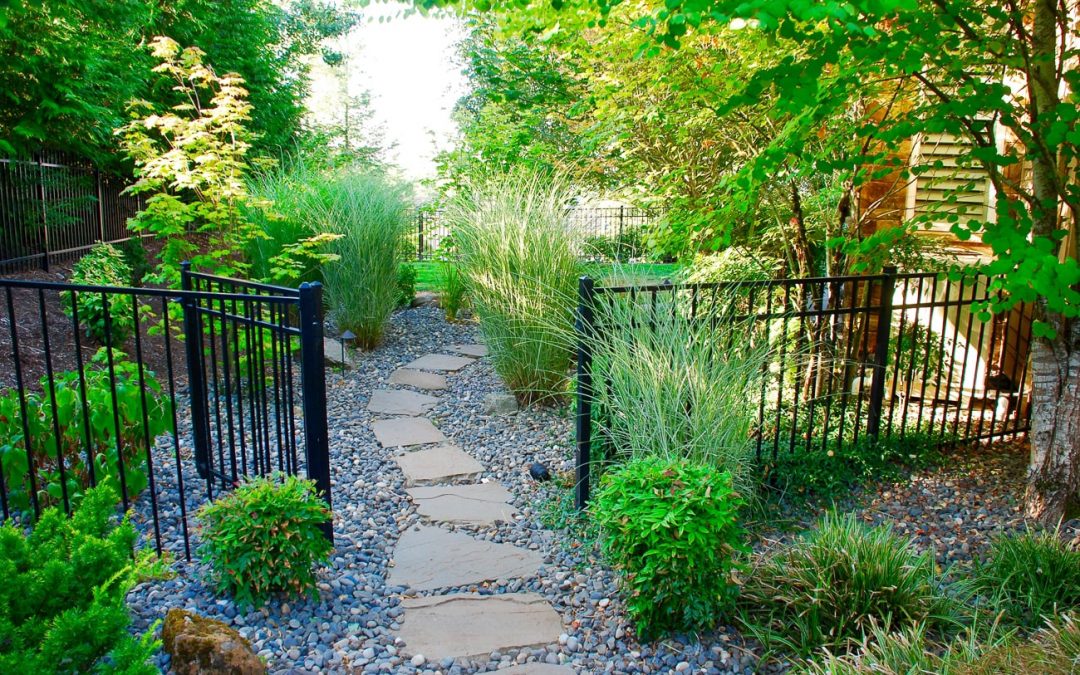Picking landscape plants is like a symphony. Blend the right plants into your yard and you have a beautiful yard year-round. Pick the wrong ones and you have chaos. Those artful “eclectic” gardens can often devolve into a jumbled mess if not carefully planned. Yes, you have to plan even if you want an “unplanned” landscape look.
Landscape Plant Categories
There are 6 major categories of plants:
Trees -fall color trees and flowering trees give stateliness and anchor your landscape. They create privacy and shade for your lawn and have a host of benefits.
Shrubs or bushes – flowering, evergreen, fall colors – shrubs are typically low growing but not always. Some shrubs can grow to about 13 feet. A typical shrub will have branches low on the trunk and tends to have a more rounded shape. Fun fact: banana trees are not trees or shrubs but are the world’s largest herb.
Vines – need to be careful picking your vines – some can be invasive or just difficult to keep from taking over. Wisteria, for example, is beautiful but needs to be carefully managed or it can do structural damage to your home.
Ground Covers – helps with ground erosion and can be evergreen or flowering. There are many ground covers that are can be stepped on. They create texture in your landscape and help prevent weeds from popping up.
Perennials – flowering, come up year after year with little encouragement these plants are the backbone of your landscape. Along with shrubs perennials provide color and variety in your landscape.
Annuals -flowering plants that grow in one single season and then die off. Depending on the geographic area annuals will need to be replanted the following year. Some plants, like Nasturtiums, drop their seeds so that the next season will have new plants without much work.
A Tapestry of Landscape Plants
To create plantings for scale put together plants of roughly the same size. Read labels to know how big they will spread and what types of light they need to grow. Keep in mind proportions. You want your landscape plants to balance out your hardscape elements. If you have a large patio and tiny plants your landscape design will feel off. On the other hand, if you plant too big or too much your landscape will feel messy and unfocused.
The elements to think about when planning your landscape plants are:
Color – this brings everything to life. It also can clash with your home colors if your palette is not chosen wisely. Harmony is the key to color. Like interior design picking color themes help unify your outdoor space and create a mood.
Pro tip: be careful with white flowers. White draws the eye and screams “look at me!’ Make sure that white plants are used for focal point areas so they don’t overwhelm other plants in your landscape.
Line – curves, straight edges, vertical and horizontal plantings all give dimension to your space. Vertical lines like trees pull the eye upward making your space feel large and expansive. Horizontal lines, such as plantings along a wall or walkway pull the eye along the ground and can give depth to your outdoor living space.
Pro tip: Want a modern and formal feel? Straight lines are the way to go. Want your space to feel more informal and add some mystery? Curved lines suggest that something is just around the bend.
Texture – flowers, trees, and bark all create the texture in your landscape. Dense plants will feel more weighty while open and airy shrubs and trees will create a feeling of lightness.
Form – Formal or informal? Plants that are more flowy will feel informal while shrubs and trees that keep their shape and are clipped will feel formal.
Scale – Like we said above, keeping everything to scale will make your landscape feel more an extension of your home.
Pro tip: Keep in mind that what you plant today will grow so if you have smaller trees and shrubs now they won’t stay that way forever. Plan accordingly. Planting too close to your home
Landscape Designers Help Your Pick the Perfect Plants

A landscape designer is valuable in getting your landscape dreams off the ground. They work with your preferences and ideas to help create a space that is both useable and beautiful.
Good landscape designers know how to put in plants for your space, soil, light, and budget. We have seen many a homeowner frustrated by their dying plants because they didn’t know what the plant needed when they planted it.
Landscape designers know the needs of the plant, such as light and water, and how big it will get when mature. (Pro tip: Tree roots in your home foundation are not a good thing.) It is a tragic day to have to cut down that beautiful mature tree you have nurtured for years because it is too close to your house.
Designers also know how to create cohesiveness. If you have existing hardscapes, landscape designers can work with those to enhance them, finding plants that follow the lines of your walls and walkways.
Landscape design is more an art than a science but with these basic elements in mind, you can create an outdoor space that is perfect.
Need Help with Your Landscape Design?
For over 20 years, Greenhaven has been designing beautiful landscapes for home and commercial properties. Yours could be our next project. Contact us to find out how we can help you get a beautiful yard.


Trackbacks/Pingbacks